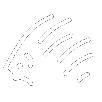Systematics and taxonomy overview
Conventionally, species belonging to the orders of Rodents, Soricomorphs and Erinaceomorphs are included among the small mammals. However, from a phylogenetic point of view, small mammals do not represent a natural entity since these three orders are evolutionarily very distant from each other.
The order of Rodents, which includes many small mammals such as mice, rats, voles, glirids and squirrels, is the largest order of living mammals with about 2300 species that represent approximately 42% of the world mammal biodiversity (Wilson & Reeder, 2005). This order is phylogenetically similar to the order of Lagomorphs (hares and rabbits) and is included in the superorder Euarchontoglires together with primates and tupaias.
Until a few years ago, the orders of the Erinaceomorphs (represented only by hedgehogs in Europe) and Soricomorphs (shrews, white-toothed shrews and moles) were both included in the order of Insectivores (together with Afrosoricids), while today, on the basis of morphological, paleontological and genetic evidence, they are considered two distinct orders. Soricomorphs and Erinaceomorphs are both included in the superorder Laurasiatheria along with bats, cetaceans, ungulates, and carnivores.
Small mammals in Italy: origin and evolution
With the exception of some species, such as the house mouse and rats that reached Italy thanks to human transport, most of the species of small mammals currently present in Italy originated in the Pleistocene and arrived to the peninsula following migratory routes strictly correlated with the Quaternary climatic oscillations.
Currently, small mammals of the Italian peninsula are represented by about 46 species spread in different types of habitats with very different ecological characteristics. Italy includes some endemic species such as Talpa romana, Sorex samniticus, Crocidura sicula and Microtus brachycercus, in addition to some insular endemisms at the subspecific level such as the sardinian populations of garden dormouse (Elyomys quercinus sardus) and dormouse (Glis glis melonii). Furthermore, recent studies have highlighted a high diversity of Italian populations for several species, including the squirrel and the reddish vole, and it is possible that these may actually represent different subspecies.
During their evolutionary history small mammals, and in particular rodents, have undergone an enormous adaptive pression that has promoted the formation of many species characterized by extremely different morphologies and ecologies. This high variability has made small mammals an excellent model for studying microevolution and, today, many studies aim at understanding the patterns of morphological variation and the levels of inter- and intra-specific genetic differentiation. In particular, in recent years, phylogenetic and phylogeographic studies have shed new light on the effect of Pleistocene climate changes on the distribution and differentiation of small mammals in Europe and, additionally, on the role of the Italian peninsula as an area of refuge and genetic and morphological differentiation. Italy, together with the Iberian and Balkan peninsulas, is today an area characterized by a high level of endemism and diversity that has yet to be fully described.




